+ Open data
Open data
- Basic information
Basic information
| Entry | Database: EMDB / ID: EMD-23407 | ||||||||||||||||||||||||||||||||||||
|---|---|---|---|---|---|---|---|---|---|---|---|---|---|---|---|---|---|---|---|---|---|---|---|---|---|---|---|---|---|---|---|---|---|---|---|---|---|
| Title | Map of full mutant cScap/Fab complex | ||||||||||||||||||||||||||||||||||||
 Map data Map data | Map of Scap(D435VB)/Insig-1/4G10 complex complex. Low pass filtered by local resolution | ||||||||||||||||||||||||||||||||||||
 Sample Sample |
| ||||||||||||||||||||||||||||||||||||
| Function / homology |  Function and homology information Function and homology informationRegulation of cholesterol biosynthesis by SREBP (SREBF) / SREBP-SCAP complex / regulation of cholesterol biosynthetic process / sterol binding / SREBP signaling pathway / regulation of fatty acid biosynthetic process / cholesterol metabolic process / ER to Golgi transport vesicle membrane / positive regulation of cholesterol biosynthetic process / response to insulin ...Regulation of cholesterol biosynthesis by SREBP (SREBF) / SREBP-SCAP complex / regulation of cholesterol biosynthetic process / sterol binding / SREBP signaling pathway / regulation of fatty acid biosynthetic process / cholesterol metabolic process / ER to Golgi transport vesicle membrane / positive regulation of cholesterol biosynthetic process / response to insulin / response to hypoxia / immune response / Golgi membrane / endoplasmic reticulum membrane Similarity search - Function | ||||||||||||||||||||||||||||||||||||
| Biological species |    | ||||||||||||||||||||||||||||||||||||
| Method | single particle reconstruction / cryo EM / Resolution: 4.6 Å | ||||||||||||||||||||||||||||||||||||
 Authors Authors | Kober DL / Radhakrishnan A / Goldstein JL / Brown MS / Clark LD / Bai X-C / Rosenbaum DM | ||||||||||||||||||||||||||||||||||||
| Funding support |  United States, United States,  France, 11 items France, 11 items
| ||||||||||||||||||||||||||||||||||||
 Citation Citation |  Journal: Cell / Year: 2021 Journal: Cell / Year: 2021Title: Scap structures highlight key role for rotation of intertwined luminal loops in cholesterol sensing. Authors: Daniel L Kober / Arun Radhakrishnan / Joseph L Goldstein / Michael S Brown / Lindsay D Clark / Xiao-Chen Bai / Daniel M Rosenbaum /  Abstract: The cholesterol-sensing protein Scap induces cholesterol synthesis by transporting membrane-bound transcription factors called sterol regulatory element-binding proteins (SREBPs) from the endoplasmic ...The cholesterol-sensing protein Scap induces cholesterol synthesis by transporting membrane-bound transcription factors called sterol regulatory element-binding proteins (SREBPs) from the endoplasmic reticulum (ER) to the Golgi apparatus for proteolytic activation. Transport requires interaction between Scap's two ER luminal loops (L1 and L7), which flank an intramembrane sterol-sensing domain (SSD). Cholesterol inhibits Scap transport by binding to L1, which triggers Scap's binding to Insig, an ER retention protein. Here we used cryoelectron microscopy (cryo-EM) to elucidate two structures of full-length chicken Scap: (1) a wild-type free of Insigs and (2) mutant Scap bound to chicken Insig without cholesterol. Strikingly, L1 and L7 intertwine tightly to form a globular domain that acts as a luminal platform connecting the SSD to the rest of Scap. In the presence of Insig, this platform undergoes a large rotation accompanied by rearrangement of Scap's transmembrane helices. We postulate that this conformational change halts Scap transport of SREBPs and inhibits cholesterol synthesis. | ||||||||||||||||||||||||||||||||||||
| History |
|
- Structure visualization
Structure visualization
| Movie |
 Movie viewer Movie viewer |
|---|---|
| Structure viewer | EM map:  SurfView SurfView Molmil Molmil Jmol/JSmol Jmol/JSmol |
| Supplemental images |
- Downloads & links
Downloads & links
-EMDB archive
| Map data |  emd_23407.map.gz emd_23407.map.gz | 47.1 MB |  EMDB map data format EMDB map data format | |
|---|---|---|---|---|
| Header (meta data) |  emd-23407-v30.xml emd-23407-v30.xml emd-23407.xml emd-23407.xml | 18.5 KB 18.5 KB | Display Display |  EMDB header EMDB header |
| FSC (resolution estimation) |  emd_23407_fsc.xml emd_23407_fsc.xml | 9.7 KB | Display |  FSC data file FSC data file |
| Images |  emd_23407.png emd_23407.png | 17.6 KB | ||
| Archive directory |  http://ftp.pdbj.org/pub/emdb/structures/EMD-23407 http://ftp.pdbj.org/pub/emdb/structures/EMD-23407 ftp://ftp.pdbj.org/pub/emdb/structures/EMD-23407 ftp://ftp.pdbj.org/pub/emdb/structures/EMD-23407 | HTTPS FTP |
-Validation report
| Summary document |  emd_23407_validation.pdf.gz emd_23407_validation.pdf.gz | 327.6 KB | Display |  EMDB validaton report EMDB validaton report |
|---|---|---|---|---|
| Full document |  emd_23407_full_validation.pdf.gz emd_23407_full_validation.pdf.gz | 327.1 KB | Display | |
| Data in XML |  emd_23407_validation.xml.gz emd_23407_validation.xml.gz | 11.2 KB | Display | |
| Data in CIF |  emd_23407_validation.cif.gz emd_23407_validation.cif.gz | 14.6 KB | Display | |
| Arichive directory |  https://ftp.pdbj.org/pub/emdb/validation_reports/EMD-23407 https://ftp.pdbj.org/pub/emdb/validation_reports/EMD-23407 ftp://ftp.pdbj.org/pub/emdb/validation_reports/EMD-23407 ftp://ftp.pdbj.org/pub/emdb/validation_reports/EMD-23407 | HTTPS FTP |
-Related structure data
- Links
Links
| EMDB pages |  EMDB (EBI/PDBe) / EMDB (EBI/PDBe) /  EMDataResource EMDataResource |
|---|---|
| Related items in Molecule of the Month |
- Map
Map
| File |  Download / File: emd_23407.map.gz / Format: CCP4 / Size: 75.1 MB / Type: IMAGE STORED AS FLOATING POINT NUMBER (4 BYTES) Download / File: emd_23407.map.gz / Format: CCP4 / Size: 75.1 MB / Type: IMAGE STORED AS FLOATING POINT NUMBER (4 BYTES) | ||||||||||||||||||||||||||||||||||||||||||||||||||||||||||||||||||||
|---|---|---|---|---|---|---|---|---|---|---|---|---|---|---|---|---|---|---|---|---|---|---|---|---|---|---|---|---|---|---|---|---|---|---|---|---|---|---|---|---|---|---|---|---|---|---|---|---|---|---|---|---|---|---|---|---|---|---|---|---|---|---|---|---|---|---|---|---|---|
| Annotation | Map of Scap(D435VB)/Insig-1/4G10 complex complex. Low pass filtered by local resolution | ||||||||||||||||||||||||||||||||||||||||||||||||||||||||||||||||||||
| Projections & slices | Image control
Images are generated by Spider. | ||||||||||||||||||||||||||||||||||||||||||||||||||||||||||||||||||||
| Voxel size | X=Y=Z: 1.08 Å | ||||||||||||||||||||||||||||||||||||||||||||||||||||||||||||||||||||
| Density |
| ||||||||||||||||||||||||||||||||||||||||||||||||||||||||||||||||||||
| Symmetry | Space group: 1 | ||||||||||||||||||||||||||||||||||||||||||||||||||||||||||||||||||||
| Details | EMDB XML:
CCP4 map header:
| ||||||||||||||||||||||||||||||||||||||||||||||||||||||||||||||||||||
-Supplemental data
- Sample components
Sample components
-Entire : Ternary complex of Scap with Fab fragment
| Entire | Name: Ternary complex of Scap with Fab fragment |
|---|---|
| Components |
|
-Supramolecule #1: Ternary complex of Scap with Fab fragment
| Supramolecule | Name: Ternary complex of Scap with Fab fragment / type: complex / ID: 1 / Parent: 0 / Macromolecule list: all Details: Fab fragment generated by proteolytic cleavage of IgG antibody |
|---|---|
| Molecular weight | Theoretical: 50 KDa |
-Supramolecule #2: Scap
| Supramolecule | Name: Scap / type: complex / ID: 2 / Parent: 1 / Macromolecule list: #1-#2 |
|---|---|
| Source (natural) | Organism:  |
| Recombinant expression | Organism:  Homo sapiens (human) Homo sapiens (human) |
-Supramolecule #3: 4G10 Fab
| Supramolecule | Name: 4G10 Fab / type: complex / ID: 3 / Parent: 1 / Macromolecule list: #3-#4 Details: Fab fragment generated by proteolytic cleavage of IgG antibody |
|---|---|
| Source (natural) | Organism:  |
-Macromolecule #1: Sterol regulatory element-binding protein cleavage-activating protein
| Macromolecule | Name: Sterol regulatory element-binding protein cleavage-activating protein type: protein_or_peptide / ID: 1 / Enantiomer: LEVO |
|---|---|
| Source (natural) | Organism:  |
| Recombinant expression | Organism:  Homo sapiens (human) Homo sapiens (human) |
| Sequence | String: PAMTLTEKLR ERISRAFYNH GLLCASYPIP IILFTGLCIL ACCYPLLKLP LPGTGPVEFS TPVKDYFPPS PDVVSQQGDL SERPDWYVGA PVAYIQQIFV KATVSPWQKN FLAVDVFRSP LSRVFQLVEE IRNHALRDSS GVKSLEEVCL QVTDLLPGLK KLRNLLPEHG ...String: PAMTLTEKLR ERISRAFYNH GLLCASYPIP IILFTGLCIL ACCYPLLKLP LPGTGPVEFS TPVKDYFPPS PDVVSQQGDL SERPDWYVGA PVAYIQQIFV KATVSPWQKN FLAVDVFRSP LSRVFQLVEE IRNHALRDSS GVKSLEEVCL QVTDLLPGLK KLRNLLPEHG CLLLSPGNFW QNDRERFNAD PDIIKTIHQH EPKALQTSAT LKDLLFGLPG KYSGVNLYNR KRVVSYTVTL GLQRYDSRFL SSLRSRLKLL HPSPNCTLRE DSIVHVHFKE EIGIAELIPL VTTYIILFAY IYFSTRKIDM VKSKWGLALA AVVTVLSSLL MSVGLCTLFG LTPTLNGGSV PVSFREIFPY LVVVIGLENV LVLTKSVVST PVDLEVKLRI AQGLSNESWS IMKNMATELG IILIGYFTLV PAIQEFCLFA VVGLVSVFFL QMLFFTTVLS IDIRRMELAD LNKRLPAEAC LPPAKPASRS QRYERQPAVR PATPHTITLQ PSSFRNLRLP KRLRVIYFFA RTRLAQRLIM AGTVIWIGIL VYTDPAGLRT YLTSQVTEQS PLGEAGLPPM PVPGGVLPAG DPKIDLSVFP SDPIQLSENQ TQQREQQAGL EPLGRLETNQ HSWAQGPEGR GNGQTELGTE AEVTWGAEDE EIWRKLSFRH WPSLFSYYNI TLAKRYISIL PAIPVTLYLN PQEALEVRHP QEANRYHPFL SSSGGKLNAE AQPDQTSSRL QGHRDVTLYK VAALGLASGI LLVLLLFCLY RLLCPKNYGQ NGLSHSRRRR GDLPCDDYGY SPPETEIVPL VLRGHLMDIE CLASDGMLLV SCCLVGQIRV WDAQTGDCLT VIPKPRLRRD SSGIFDYQES WDHSPDGKTG LDDSFESSHQ LKRMLSPPQP PLFCDQPDLT SLIDTNFSEQ VKVAESEPRL RAVGGRQKEA GYDFSSLVGK VYEEHSTSNC MNFGGLSAPH GQAGFCVGGS TARSLGCGSE EGGCGGRRRS LGDESLSGFD KSSPLPSWGG DFESSVWSLD LQGNLIVAGR SNGKLEVWDA IEGTLRSSND ESQSGITALV FLNNRIVAAR LNGSLDFFSL ETHTSLNHLQ FRGAPSRSSI PSSPLFSSSD VIVCQLTHTV SCAHQKPITA LKAAAGRLVT GSQDHTLRVF RLEDSCCLFT LQGHSGAITA VYIDQTMVLA SGGQDGAICL WDVLTGSKVS HMYAHRGDVT SLTCTTSCVI SSGLDDVISI WDRSSGIKLY SIQQEMGCGS SLGVISDNLL VTGGQGCVSF WDIGYGDLLQ TVYLGKSNES QPARQILVLE NAAIVCNFGS ELSLVYVPSV LEKLDDYKDD DDKGSDYKDD DDKGSDYKDD DDK |
-Macromolecule #2: Insig-1
| Macromolecule | Name: Insig-1 / type: protein_or_peptide / ID: 2 / Enantiomer: LEVO |
|---|---|
| Source (natural) | Organism:  |
| Recombinant expression | Organism:  Homo sapiens (human) Homo sapiens (human) |
| Sequence | String: MTGPKADAMQ SPSPSAGRAE REASGGSATT WRQHLVQRSV VLFVVGAFMA LVLNLLQIQR NVTLFPDEVI ATLFSSAWWV PPCCGTAAAV VGLLYPCIDS HLGEPHKFKR EWASVMRCIA VFVGINHASA KLDFANNVQL SLTLAALSLG LWWTFDRSRS GLGLGITIAF ...String: MTGPKADAMQ SPSPSAGRAE REASGGSATT WRQHLVQRSV VLFVVGAFMA LVLNLLQIQR NVTLFPDEVI ATLFSSAWWV PPCCGTAAAV VGLLYPCIDS HLGEPHKFKR EWASVMRCIA VFVGINHASA KLDFANNVQL SLTLAALSLG LWWTFDRSRS GLGLGITIAF VATLITQFLV YNGVYQYTSP DFLYIRSWLP CIFFSGGVTV GNIGRQLAMG IPEKPHNDSR ENLYFQGGSG ATNFSLLKQA GDVEENPG |
-Macromolecule #3: 4G10 Fab light chain
| Macromolecule | Name: 4G10 Fab light chain / type: protein_or_peptide / ID: 3 / Enantiomer: LEVO |
|---|---|
| Source (natural) | Organism:  |
| Sequence | String: DIQMTQTTSS LSASLGDRVT ISCRASQDIR NYLNWYQQKP DGTVKLLIYY TSRLHSGVPS RFSGSGSGTD YSLTISNLEQ EDIATYFCQQ TNTLPWTFGG GTKVEIKRTV AAPSVFIFPP SDEQLKSGTA SVVCLLNNFY PREAKVQWKV DNALQSGNSQ ESVTEQDSKD ...String: DIQMTQTTSS LSASLGDRVT ISCRASQDIR NYLNWYQQKP DGTVKLLIYY TSRLHSGVPS RFSGSGSGTD YSLTISNLEQ EDIATYFCQQ TNTLPWTFGG GTKVEIKRTV AAPSVFIFPP SDEQLKSGTA SVVCLLNNFY PREAKVQWKV DNALQSGNSQ ESVTEQDSKD STYSLSSTLT LSKADYEKHK VYACEVTHQG LSSPVTKSFN RGEC |
-Macromolecule #4: 4G10 Fab heavy chain
| Macromolecule | Name: 4G10 Fab heavy chain / type: protein_or_peptide / ID: 4 / Enantiomer: LEVO |
|---|---|
| Source (natural) | Organism:  |
| Sequence | String: TGVHSEVQLQ QSGAELVRPG ASVKLSCTAS GFKIKDDYIH WVKQRPEQGL EWIGRIDPAN GHTRYAPKFQ DKATITADTS SNTAYLQLSS LTSEDTAVYY CTRYNDYDAF YFDYWGQGTT LTVSSASTKG PSVFPLAPSS KSTSGGTAAL GCLVKDYFPE PVTVSWNSGA ...String: TGVHSEVQLQ QSGAELVRPG ASVKLSCTAS GFKIKDDYIH WVKQRPEQGL EWIGRIDPAN GHTRYAPKFQ DKATITADTS SNTAYLQLSS LTSEDTAVYY CTRYNDYDAF YFDYWGQGTT LTVSSASTKG PSVFPLAPSS KSTSGGTAAL GCLVKDYFPE PVTVSWNSGA LTSGVHTFPA VLQSSGLYSL SSVVTVPSSS LGTQTYICNV NHKPSNTKVD KRVEPKSCDK T |
-Experimental details
-Structure determination
| Method | cryo EM |
|---|---|
 Processing Processing | single particle reconstruction |
| Aggregation state | particle |
- Sample preparation
Sample preparation
| Concentration | 5 mg/mL | ||||||||||||||||||
|---|---|---|---|---|---|---|---|---|---|---|---|---|---|---|---|---|---|---|---|
| Buffer | pH: 7.5 Component:
| ||||||||||||||||||
| Vitrification | Cryogen name: ETHANE / Instrument: FEI VITROBOT MARK IV |
- Electron microscopy
Electron microscopy
| Microscope | FEI TITAN KRIOS |
|---|---|
| Image recording | Film or detector model: GATAN K3 BIOQUANTUM (6k x 4k) / Average electron dose: 1.6 e/Å2 |
| Electron beam | Acceleration voltage: 300 kV / Electron source:  FIELD EMISSION GUN FIELD EMISSION GUN |
| Electron optics | Illumination mode: FLOOD BEAM / Imaging mode: BRIGHT FIELD |
| Experimental equipment |  Model: Titan Krios / Image courtesy: FEI Company |
 Movie
Movie Controller
Controller



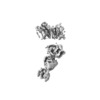






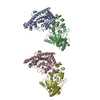
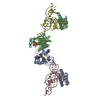
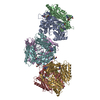
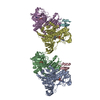
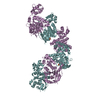
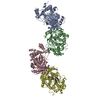
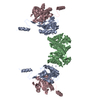
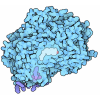
 Z (Sec.)
Z (Sec.) Y (Row.)
Y (Row.) X (Col.)
X (Col.)






















